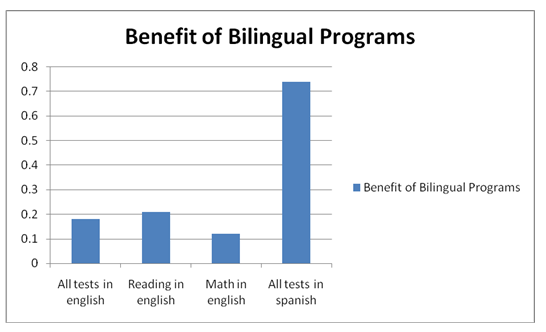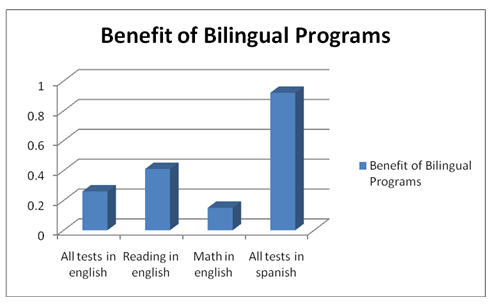Abstract
Not many kindergartens have welcomed the idea of bilingual education. They fail to appreciate the importance of a bilingual approach to early child education and the pertinent benefits that accrue to such a system. This report presents the case for this educational approach providing a research analysis of proven benefits of this system.
Introduction
There are many kindergartens out there that claim to offer the best child care based on their facilities and physical structures. This is partly true because our kindergarten has modernized set facilities that will allow the child to enjoy themselves as that learn and interact with their peers.
This specific kindergarten stands out from all the others by the fact that it provides the child with a wider scope of options in the learning approach. Of specific interest is the bilingual system that allows the child to learn in more than one language.
Bilingual learning system has formed a vibrant source of discussion for the edifying experts. The existing situational studies suggest that there is little difference between students that have undergone through the bilingual education system and those who take the English only system. These studies however fail substantially in providing an analysis of the individual program traits and characteristics.
The success or otherwise of any education system depends on the quality of the output that is made into the sector along with the influence of the various contextual factors. A bilingual system similarly seeks to enhance a student’s literacy and proficiency in language easing the most convenient language that is best known to them. The system also seeks to enhance social and cultural integration.
The extent of development of either language is pegged heavily on the individual systems objective and goal. As it were there are various varying methods of measuring academic excellence. The general method has been to monitor the student’s academic performance to ascertain their progress and response to the education system.
There are others who choose to perform life skill tests that are aimed at evaluating the Childs ability to adopt and respond to the various social and societal concerns. The level of social integration can be quantified by the child’s ability to function in the general societal context.
This paper interrogates the importance of bilingual education in providing an adequate environment for the child to learn and expand their knowledge.
The report is based on a research conducted on a sample of randomly selected children who either spoke learnt from an English only school or in a Spanish and English school. Their performance increases were recorded on a standard deviation scale and have formed the basis of this report.
Findings
Methodology
Few if any of the success assessment methodologies embrace socio-cultural integration in its evaluation criterion. Taking into consideration the role that schools play in the community, there is a need to present the educational system in the best social context. Fairness and accuracy in the evaluation of an educational system is of paramount importance in the definition and quantification of success.
Inadvertently the influence of language and culture in the assessment and determination of the levels of success and successful performance in the context of literacy and social integrative aspects of learning is largely conspicuous. The research methodology adopted random assignment to treatment of control groups in its investigation strategy concludes that the bilingual system is actually viable.
This method that is also used in medical experiments provides a better degree of credibility and reliability. It allows for the association of the difference in the systems to the treatment that is offered to them by the various systems.
Benefits of bilingual education
Language proficiency
Language forms an influential and essential part of the child’s life below the age of 10 and it is therefore important that they receive the best form of facilitation during this age. The bilingual system improves the student’s lingual potential and matures their proficiency in languages.
From the data that was formulated from the researches above the levels of proficiency among the students grew by a great margin and therefore implies that the bilingual system presents quantifiable and justifiable benefits to the child. The increase in proficiency in English can be attributed to the child’s motivation to connect the native language to the English language (Martin-Rhee and Bialystok 2008).
The control sample comprised of randomly selected sample of children in a bilingual setup that provided for native and English languages as well as an English only institution that focused on purely English based education.
The outcome from all studies done on the bilingual education system and program all indicated that the bilingual learning program was the most favored. The researchers analyzed the overall benefits of the bilingual system in test scores in English resulted in a standard deviation of 0.26.the positive effect of the use of a bilingual system was evaluated at 0.41 of a usual standards.
Graph 1: Results from the Meta-Analysis of the Effects of Bilingual Education

The results above indicate the general improvement in Maths English and Spanish subjects. There is a general improvement in these subjects with the highest being in Spanish. In the case of an English speaking student the improvement would be of equal measure in English since the study was done on Spanish native speaking students.
There is one in one hundreds chances that the results do not reflect the actual situation on the ground. This is supported by the fact that the studies on the bilingual systems are made on a random basis (Emmorey 2008)
Educational performance
The adoption of the bilingual system also increases the academic performance of the child. Others have suggested that there is no difference but none suggest that the system lowers the student’s performance. Our study suggests that there is a difference in the performance in the students in the bilingual system that works in the favor of the dual language system.
Graph 2 Results from the Meta-Analysis of the Effects of Bilingual Education for Studies with Random Assignment to Bilingual and Control Programs

From the above graph there is a general 0.92 standard deviation improvement in the child’s general performance in the child’s subjects. The sample of children in the bilingual system showed a general improvement in their academic performance in Math English and Spanish. The trend is bond to spread to all other subjects including sciences since language is at the heart of understanding of these subjects.
Even better the use of a bilingual system allows the child to relate to the class initiatives and creates a better understanding of the subject since they are able to connect to the studies in class with their mother-tongue. The bilingual system demystifies the reading and learning experience and therefore allows the child to perform better (Bialystok 2009).
Conclusion
There has been extensive research on the pros and cons of the bilingual system of learning in institutions of learning. The emerging conclusion falls in the favor of the bilingual system insisting that the success or otherwise of such a system depends on the quality of instruction that the language model adopts (Hertz-Lazarowitz 2008).
These research initiatives extend more support and credence to the notion that in the model excluding the drawbacks that may affect the execution of this approach provides a solution to the enhanced and motivated student performance. As it were the adoption of a bilingual system does not guarantee success and better performance. It therefore falls upon good practice and proper instruction.
The bilingual system is a credible and viable alternative to the single language system. It offers the child a window of greater opportunity to explore the benefits of education and provide a better approach to learning. It is therefore highly recommended that parents should allow their children to access this key to success by enrolling their children into a bilingual kindergarten.
References
Bialystok, E. (2009) Bilingualism. nd. Web.
Summary: reports on the research that has been carried out over time and suggests that being bilingual is advantageous.
Evaluation: date of report is 2009, so it is current. Published by a reliable source that is a correspondence of York University in Toronto and is an expert in behavioral sciences. Relevant because it contains information that backs up being bilingual while highlighting its advantages.
Emmorey, K. (2008) The source of enhanced cognitive control in bilinguals. National Institute of Health. Web.
Summary: reports on the cognition abilities associated with bilinguals and suggests that children improve in cognitive abilities when they learn two languages.
Evaluation: date of report is 2008, so it is current. Published by a reliable source, the National Health Insurance, concerned with the wellbeing of children. Relevant because it contains information from many authors concerning bilingualism.
Hertz-Lazarowitz, R. (2008) From ethnic segregation to bilingual education: what can bilingual education do for the future of the Israeli Society? Journal for Critical Education Policy Studies, 6, (2).
Summary: reports on the effects of language on Israel and suggests that learning different languages improves the cultural integration.
Evaluation: date of report is 2008, so it is current. Published by a reliable source. Relevant because it contains information on how negativity between communities can be reduced through language.
Martin-Rhee, M. And Bialystok, E. (2008) The Development of Two Types of Inhibitory Control in Monolingual and Bilingual Children. Web.
Summary: reports on the advantages of teaching children two languages and suggests the information acquired is important to the overall development of the child.
Evaluation: date of report is 2008, so it is current. Published by a reliable source, in York University, Canada. Relevant because it contains information that clearly lays out the advantages of bilingualism.